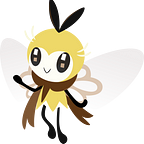I don’t remember how old I was when I first laid eyes on this painting, but I will never, ever forget what I felt. I was incredibly confused. How was this art? My parents told me the Detroit Institute of Arts was a beautiful collection, and they were absolutely right. At the time, there was a King Tut exhibit that was extremely gripping to me. At least, I think King Tut was there. I might be remembering it wrong.
What I remember is wandering into the modern art section and I was immediately floored. There was a pile of wood, what I saw as lazily bolted together in the middle of the ground. A canvas hung from the wall, single-lined trails of color curved inward toward the southern corners, dripping as if they had been spray-painted on. I attempted to find the latter on the DIA website, but I don’t have the patience to look for it. Even that was more specific than “Be I.”
“Be I” had to be the most jarring piece of art I observed at the time. My entire family was in agreement: “anyone could do that.” Anyone could throw red paint on a canvas. Anyone could strike a white line down the middle. I don’t remember what was written about the painting, but I remember thinking it was much ado about nothing.
“It’s like they found a red ping pong table and put it on display” my dad joked. I laughed, we all did. Only a few choice sculptures caught my eye. This was well over 10 years ago at this point, it’s entirely possible there’s new modern art at the DIA that would have even impressed child Brick.
This painting has never left my mind, and I am glad that it never did.
Over the years, I tried to make sense of “Be I.” I understood a few years later as I grew into a teenager that art is subjective. Some people might find the art in something as simple as a pencil balancing on a pencil balancing on a pencil.
I was a close-minded child, and that didn’t change until I was in my very late teens. All in all, not that long ago at all. I would casually mention Newman’s work in art classes, mocking it as a joke, and for a time, the reason abstract art shouldn’t be considered art at all. Just a bunch of nonsense, right?
As my perspective on many things changed I came back to the ping pong table. Saying it like that now feels derogatory. Laying eyes on it years after the fact, I not only see the beautiful detail in the red field itself but also the difficulty this piece must’ve given Barnett Newman. That white line is perfectly straight, not a drop nor a molecule of red paint is touching it. The southernmost parts of the painting are a darker red than the north, creating an eye-pleasing gradient. If nothing else, a technically impressive painting. I don’t know how critics view this work, but as a casual observer of art, I realize that no, not just anyone could do what Newman did. I was wrong.
Furthermore, I began to understand the point of abstract art. I don’t know what Newman intended when he created “Be I”, however, this painting says something incredibly straightforward to me:
Balance.
As I grow older, I pay ever more attention to the world around me. ADHD tries to keep me down in this regard, and being honest I wish it worked better sometimes. Regardless, I am much more conscious now than I was over 10 years ago.
“Be I” Is my personal heaven.
To me, the gradients masterfully portray the variables in life; not only the small but the large, the similar, and the polar opposites. The white line down the middle is a divider. It sections away two equally opposing forces, allowing two separate compartments for the chaos that is life. It is management. It is balance. That is what this painting means to me.
Often, I feel as if I struggle to have any balance at all in my life.
I will never acquire enough money to purchase this work, nor do I think I would buy it even if I had such an obscene amount of wealth, an amount I wish to never achieve. To me, this entire episode with “Be I” not only shares the ideas I have of the painting itself, but the entire journey I have with “Be I” is a reflection that things can change. At first glance, it was less than a half-eaten, dumpster-bound hamburger from a fast-food joint. Years later, it means so much to me, more than almost any other painting I’ve ever seen. There is hope for change if that is any indication.
“Be I” is my ultimate hope.
